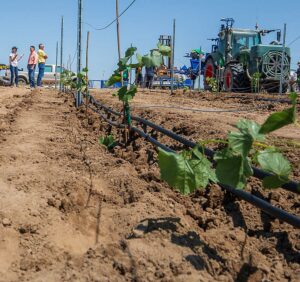
Many of the soil health questions surrounding the Long-Term Agroecological Research and Extension vineyard planted at Washington State University’s Prosser campus in 2023 will, as the name implies, require a long time to answer.
But insights into soil compaction were readily available soon after the 4-acre vineyard was mechanically planted by a machine that made deep rips in the vine rows for planting and applied heavy pressure under its tires. Moreover, lead scientist Devin Rippner realized he could compare both of those disturbed soils to a no-till vineyard and minimally disturbed field right next door.
“It’s called a space-for-time comparison. I can’t go back in time, but I can go across the street where there is a similar soil that hasn’t been disturbed, to make some comparisons,” Rippner said.
Preliminary results, using an approach akin to a medical CT scan for soil cores, reveal the structural differences at play in the compacted soils in the tractor rows and the disturbed vine rows compared to the neighboring vineyard. Rippner partnered with scientists at the Environmental Molecular Sciences Laboratory at the Pacific Northwest National Laboratory in Richland, Washington, to advance this approach using X-ray computed tomography (that’s what CT stands for in medical parlance) to provide new insights into soil structure and function.
“We can see the distributions of the mineral solids, the large chunks of organic matter, and the pores in the soil,” he said.

The pores play an important role in root growth and water infiltration, allowing for easier root growth and earthworm activity, which then creates more pores.
“It’s a chicken and egg thing. When soils are less compacted, it’s easier for roots to grow through them. Worms follow the roots, and then roots follow the worms,” Rippner said. “Soils can be really hard, so why fight it?”
More porosity also means better water capture during a rain event and less risk of runoff. That’s not a huge issue in the drip-irrigated vineyards of Eastern Washington, Rippner acknowledged, but it’s an important aspect of soil health everywhere.
Moreover, the compaction in the drive row, while significant, was not enough to impede root growth, which is good news for growers considering mechanized planting.
Compaction and water infiltration are two metrics of interest in the new, long-term soil health orchard as well. Both research plantings, along with sites in other cropping systems, are part of the Washington Soil Health Initiative. The orchard site, planted at WSU’s Sunrise Research Orchard outside Wenatchee, compares different soil amendment strategies, among other things. While the study is still in its early days as well, researchers already see lower compaction and faster water infiltration in a mulch treatment when compared to compost, cover crops or mow-and-blow treatments.
“In the second year, we are not seeing much difference — except the mulch treatment, where we are already starting to see bigger trees,” said Lee Kalcsits, during a field day at the orchard trial site last fall.
The mulch treatment conserves soil moisture, reduces evapotranspiration and increases water infiltration, he said.
Is the mulch treatment also encouraging more earthworm activity, as Rippner’s vineyard images suggest? No one has looked at that particular question yet, but Rippner plans to use the same soil core analysis technique in the research orchard in years to come.
Rippner’s larger research goal is to fine-tune the technique of using X-ray computed tomography for soils. The 3D imaging outputs about 4,000 image “slices” for each soil core, so he works to design and train computer models to do the image analysis that can discern a root from a rock.
Actually, the rocks are pretty easy. The challenge: differentiating the pore space from organic matter.
“If you have a lot of big pieces of wood, you’ll overestimate the porosity,” he said.
But new modeling approaches developed in the biomedical field — these are CT scans, after all — can also enhance accuracy of soil scanning. Rippner’s analysis tools will support a larger effort at PNNL in which scientists are building a giant database of different soils.
That refined approach should be ready by the time the soil health vineyard — with treatments including low till, no till, no herbicide, cover crops and compost — is due for a second round of scanning.
“My hope is in a couple of years to take more scans to understand how our management practices have changed the soil structure in the vineyard,” he said. •







Leave A Comment